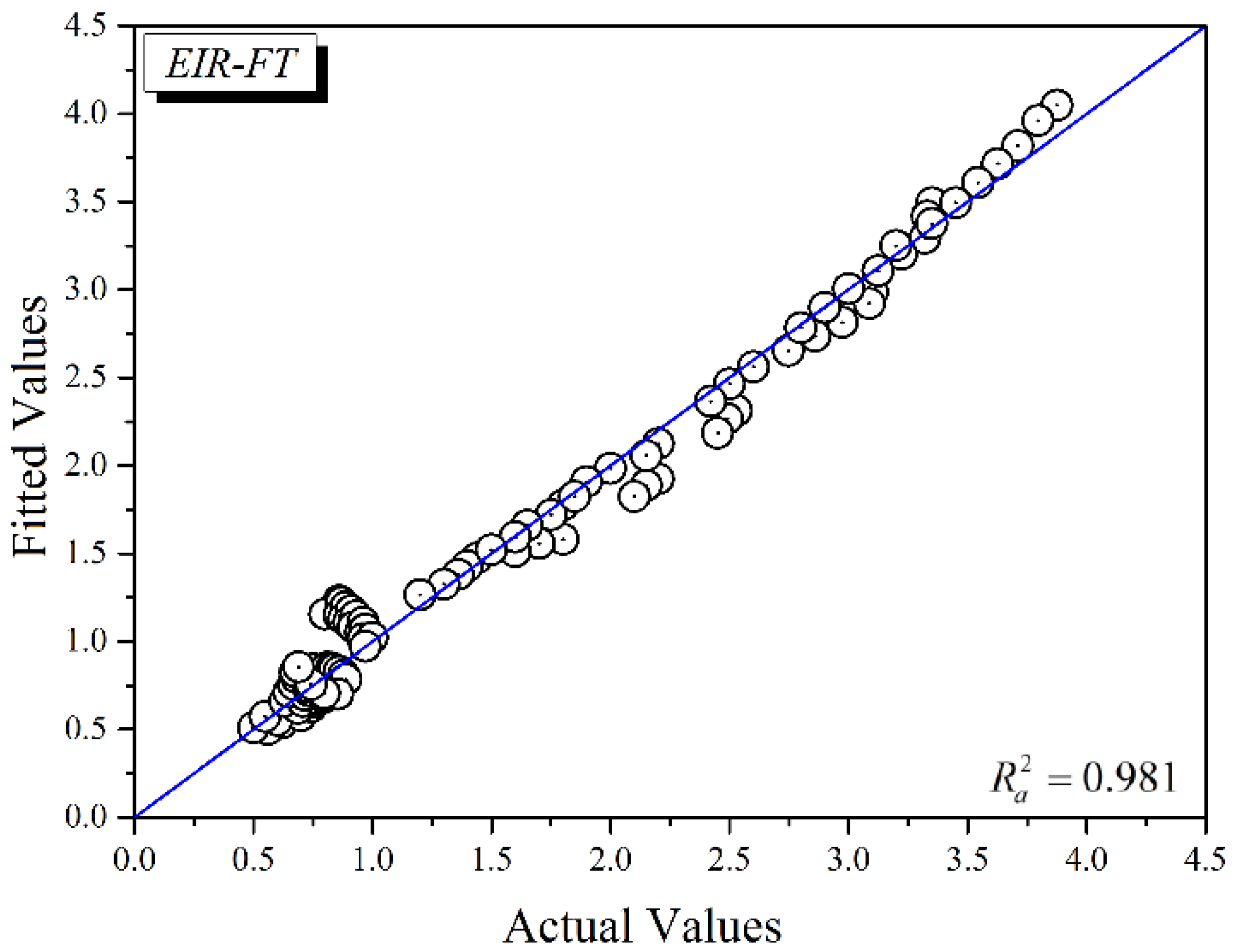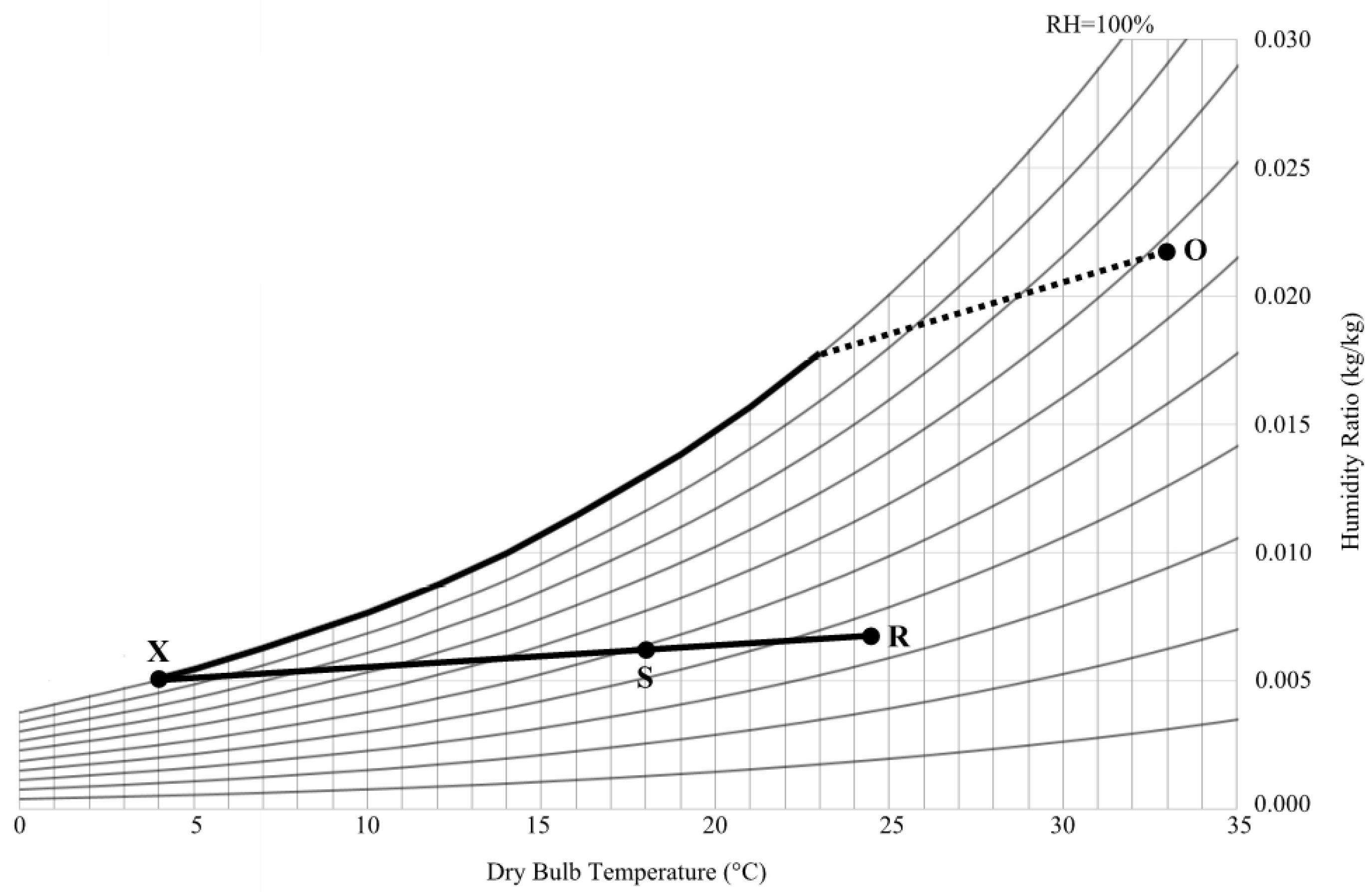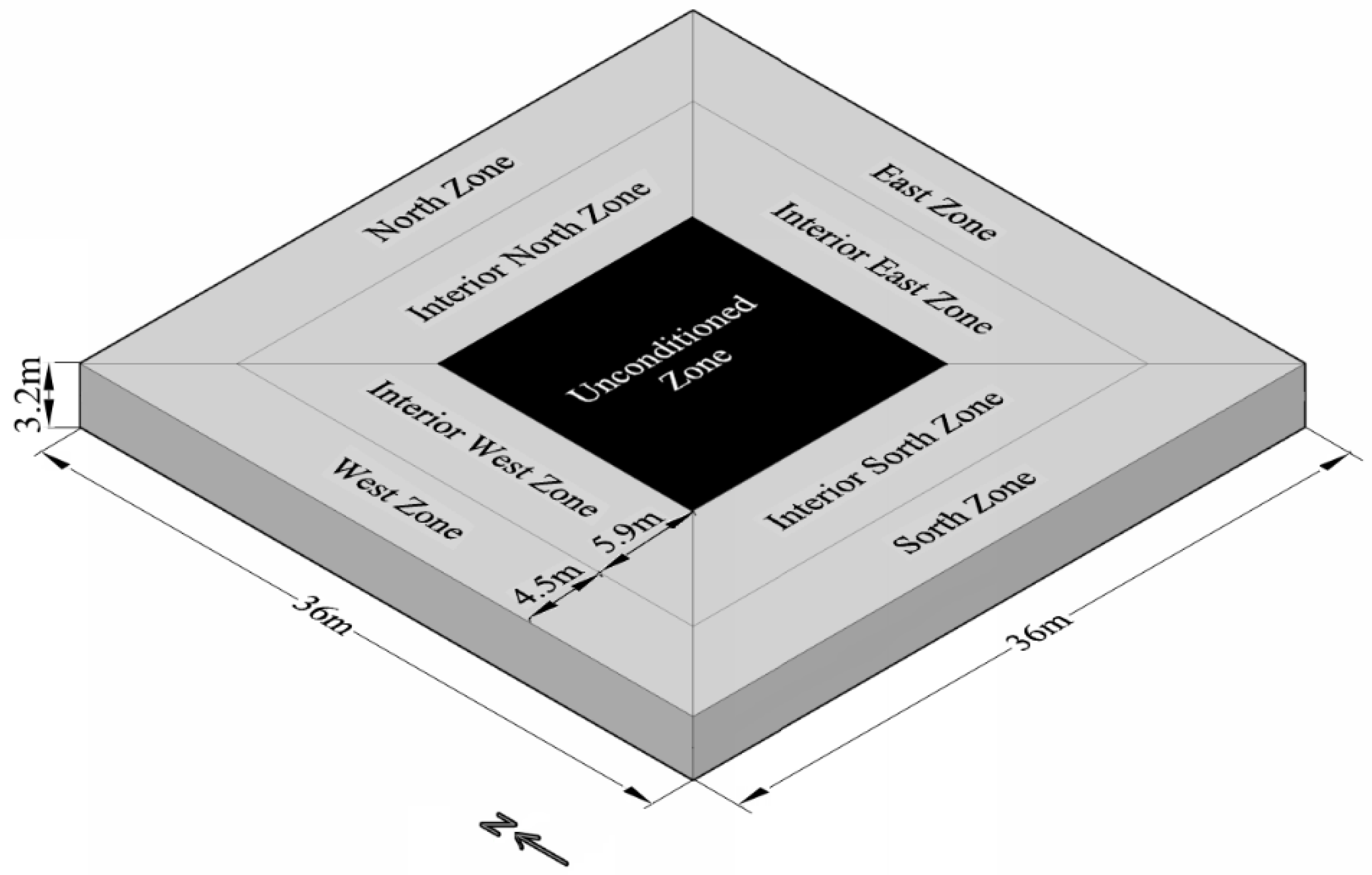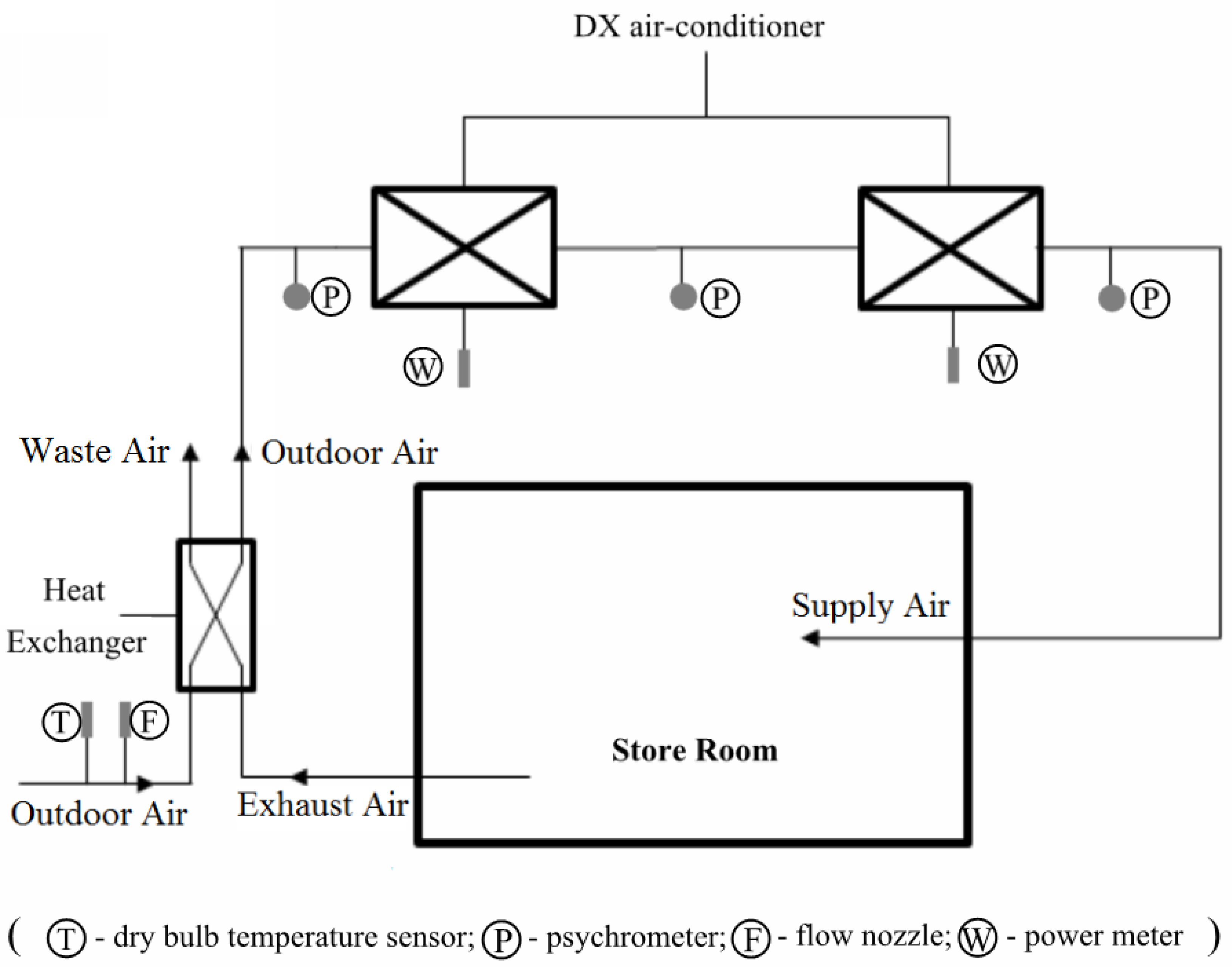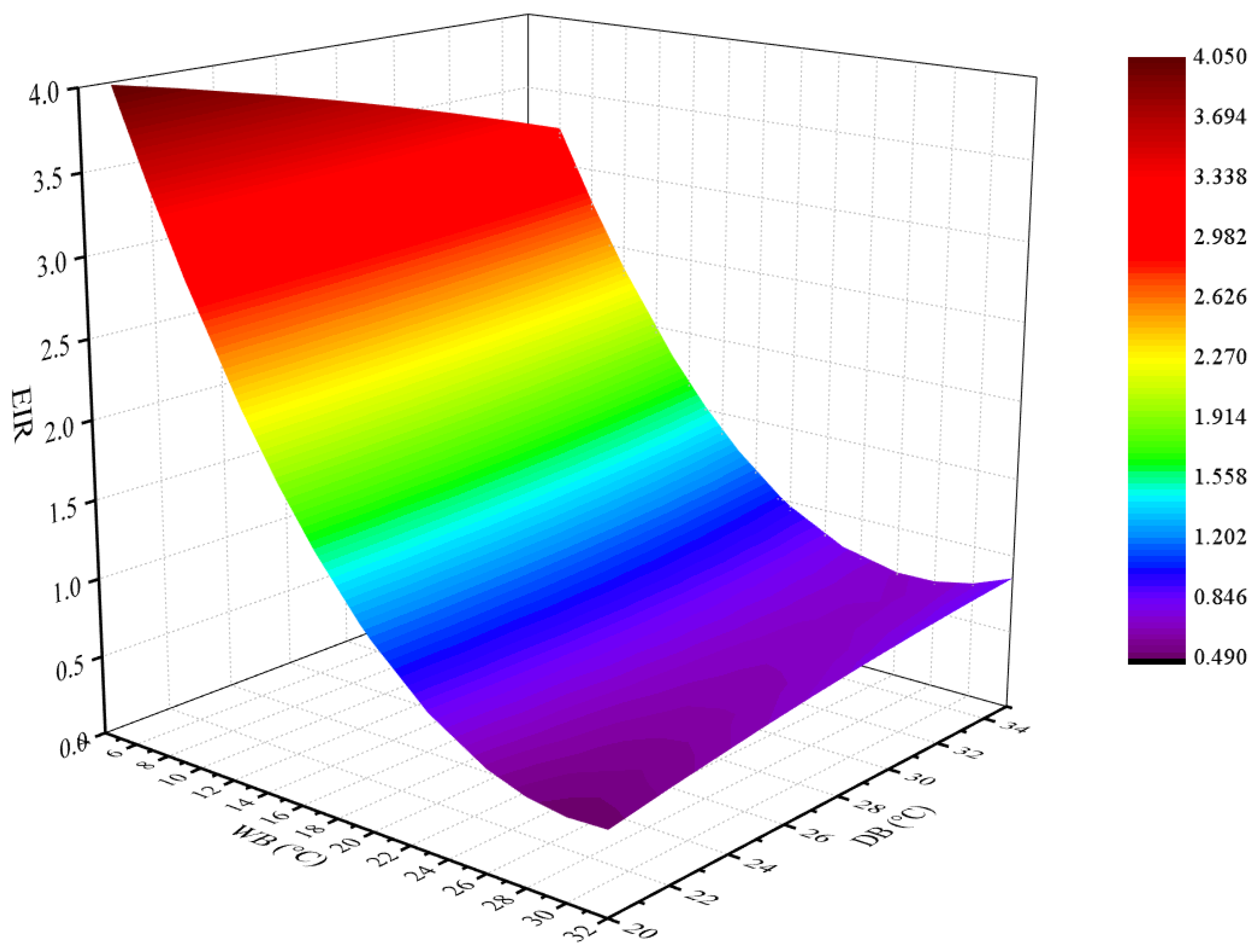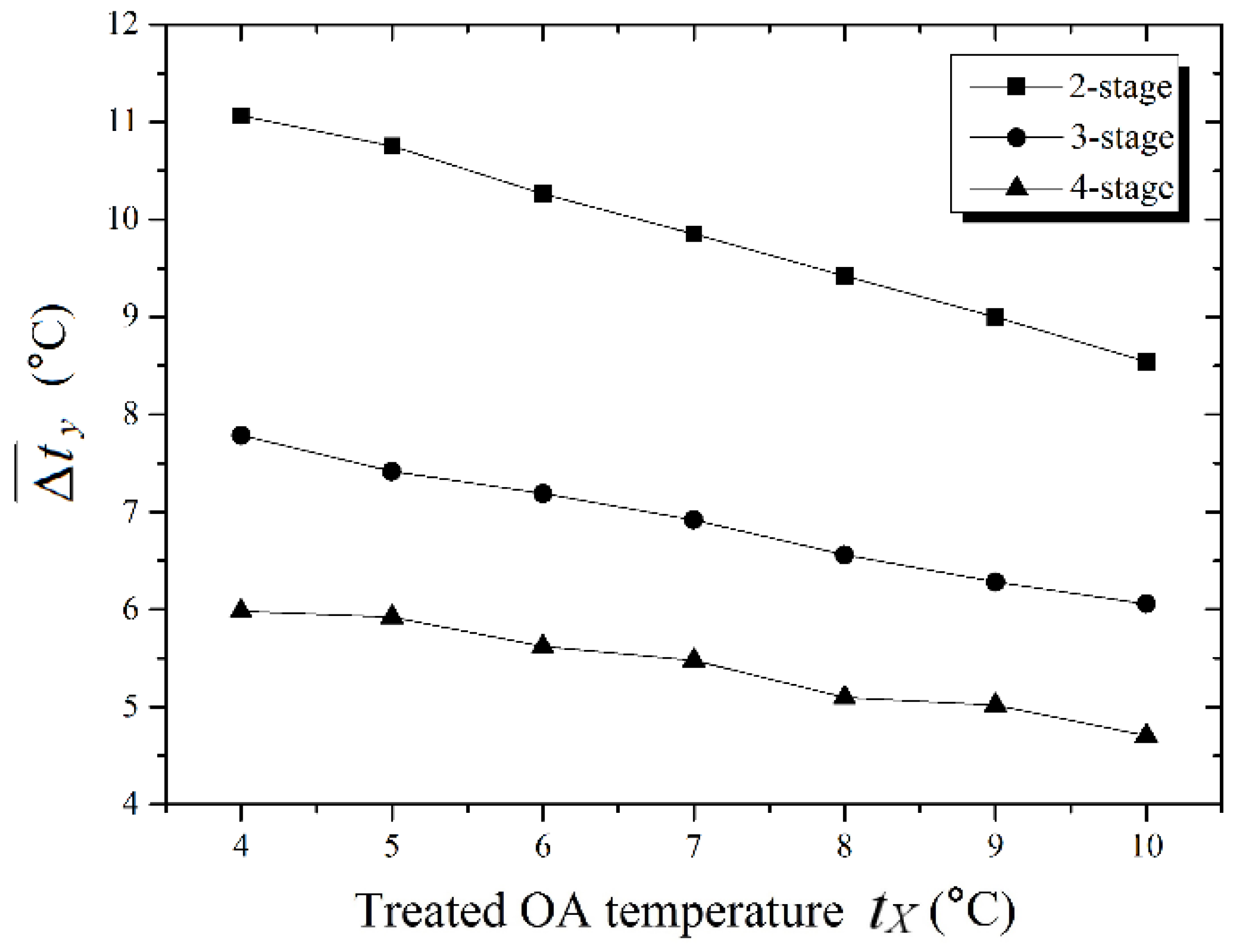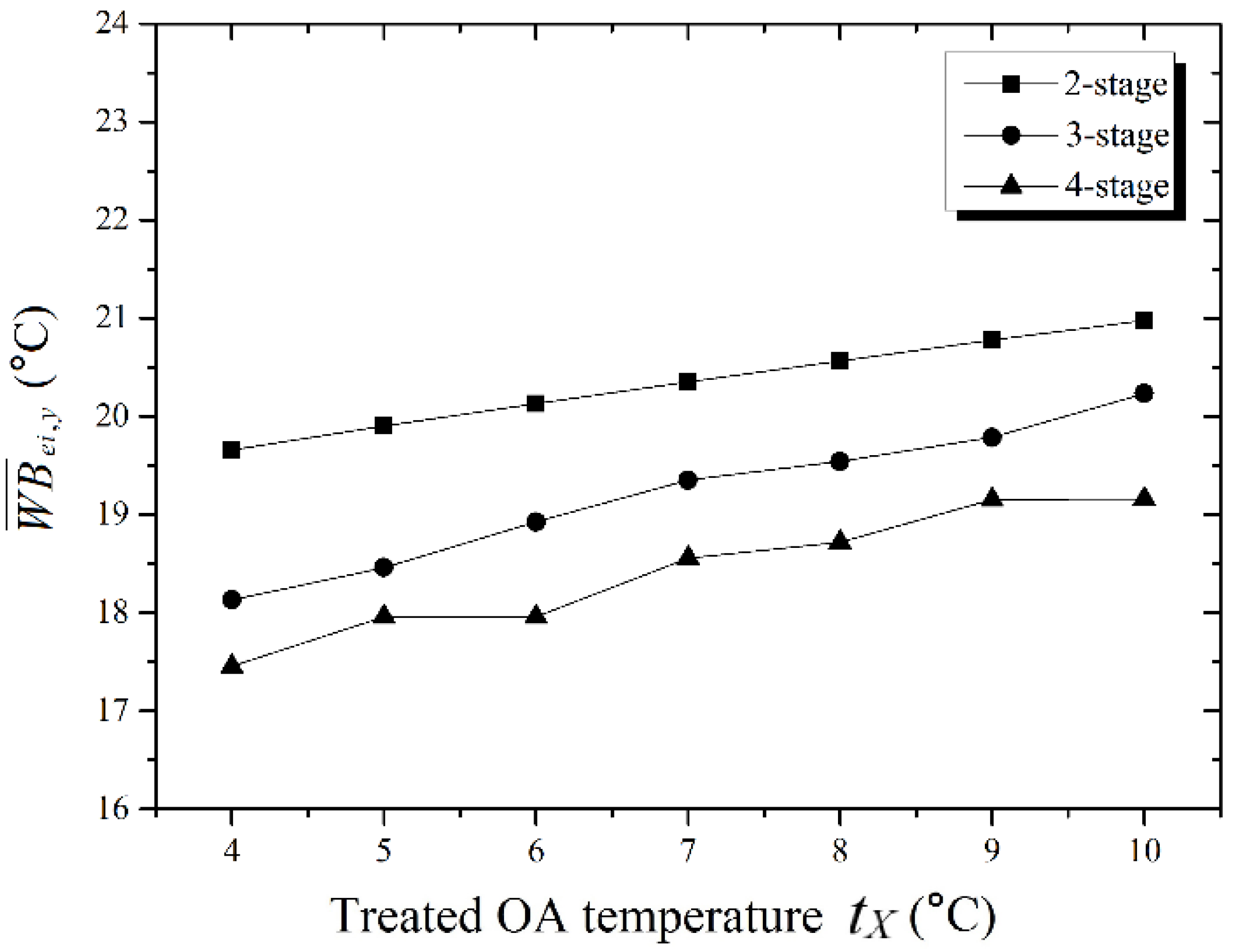1. Introduction
The use of a dedicated outdoor air system (DOAS) for air-conditioning of office buildings has been widely investigated in recent years for better indoor air quality and energy efficiency [
1]. A conventional DOAS often comprises two systems: an outdoor air (OA) system dedicated to produce high quantities of OA that handles the entire latent loads and part of the space sensible loads; and a terminal system to handle the remaining space sensible loads. As such, OA flow rate is higher and return air (RA) does not need to be circulated across different zones to enhance the indoor air quality. The OA system often uses active-desiccant technology; whilst the terminal system can be chilled beams/ceilings [
2]. Energy savings can be derived from reheating and dehumidification energy reductions. However, there are concerns with such a system configuration. The use of active-desiccant technology to produce OA, despite it is energy effective [
3], is space intensive to hinder its popular use in land scarcity cities like Hong Kong [
4]. The use of chilled beams/ceilings as a terminal system will cause condensation problem, especially in subtropical regions where summers are long, hot and humid [
2]. To solve the condensation problem, previous works proposed to keep beam/ceiling surface temperature above the indoor dew-point temperature by using different control methods [
5] and system configurations [
6] and to limit the indoor humidity gain [
7]. However, the proposed methods will unavoidably introduce constraints on the cooling capacity [
5] and operation of the terminal system [
8].
To address the concerns, research studies have been done to investigate into using other system configurations. A series of studies have been done to investigate the use of chilled water system to treat OA and the use of dry fan-coil unit as the terminal system. However, it was found that the potential energy benefit is not significant and the condensation problem still exists [
9,
10,
11]. Another study investigated the use of fan-coil unit as the OA system and chilled ceiling as the terminal system. However, it was found that condensate-free can only be achieved on the provision of a surface temperature control [
12].
Hong Kong is a subtropical city where summers are hot and humid which increases the latent load significantly. Using treated outdoor air at extra-low temperature to handle the entire space load can take advantage of the use of deep coils to reduce the by-pass factor [
13] for more efficient operation of the central cooling system. In this regard, a novel DOAS has been proposed [
14]. The proposed DOAS system is a cold air distribution system that consists of a DOAS central system to produce extra-low temperature (XT) OA to handle the entire space cooling load and a mixing chamber as the terminal system for XT OA and RA. With this configuration, no cooling is required at the conditioned space to avoid condensation problems.
The central system is a variable speed multi-stage direct expansion (DX) unit. A DX unit is used because of its ability to operate at low evaporator temperatures to achieve the intended cooling and dehumidification objectives [
15]. Energy savings are associated with the use of XT OA, variable speed system and multi-stage configuration. Dry XT OA enables the use of high-temperature and low-humidity indoor design condition to save energy [
16]. Variable-speed system capable of regulating its motor speed to modulate output is considered more energy efficient [
17]. The multi-stage configuration, which is a novel concept, enables improved equipment performance associated with working under higher evaporator temperatures (1st stage) and smaller temperature lifts (between evaporator and condenser) [
18]. It also enables the use of different control strategies to have further energy benefits [
19].
A series of studies have been conducted by the authors to confirm the effective usage of the proposed XT-DOAS in a Hong Kong office environment. Based on the use of different system configurations, it was found that the proposed system, as compared to the conventional system, can reduce the annual indoor discomfort hours by 16.2% to 69.4%, the annual air-conditioning energy use by 12% to 22.6%, and the condensation risk to almost zero [
14,
20,
21]. The desired indoor relative humidity can also be better achieved [
14]. However, in these studies, the analyses were focused on performance comparison with conventional system and were done based on a conventional coil performance model. This is acceptable for previous studies, but for optimizing the system configuration to achieve desirable air conditions and better energy efficiency, it is not desirable because XT-DOAS receives hot and humid OA at the first cooling stage and handles extra-low temperature air at the last cooling stage to introduce substantial influence on the DX coil’s performance [
22]. Unfortunately, a performance curve that takes into account the extra-high temperature range is lacking in the public literature.
Using parallel-connected units to meet cooling demand is commonly seen in central chilled water systems. A lot of studies have been done to investigate the influence of different designs on the system’s overall performance including heat rejection mediums [
23], ambient conditions [
24], compressor efficiencies [
25], unit capacities [
26] and part load performances [
27]. However, for the series-connected multi-stage DX system, the overall performance is not only affected by the above factors, but also affected by the entering air thermodynamic states at different part load conditions. Previous work is virtually none.
As for energy performance evaluation, previous studies rarely take into account the exergy efficiency [
28]. Exergy analysis is based on the second law of thermodynamics. It can identify localized inefficiencies and thus is commonly used for the design, and performance evaluation of energy systems [
29]. For the proposed XT-DOAS using series-connected multi-stage DX system, the moist air entering and leaving individual cooling stages is of different states to affect the available energy and thus the exergy efficiency [
30]. Therefore, exergy analysis is essential for the optimum design of multi-stage DX system. Considering that both energy use and exergy loss are essential energy system characteristics, the authors had conducted an exergy analysis on XT-DOAS and confirmed that it was more energy efficient than conventional system [
21]. However, in the previous study, the multi-stage DX system was regarded as an integral component. The multi-stage characteristic had not been considered.
Given the limitations of previous studies, this study aims to develop a realistic coil performance to optimize the system configuration of XT-DOAS aiming to achieve desirable air conditions and better energy efficiency. The energy efficiency evaluations will be based on energy as well as exergy analyses to take into account the combined influence of the thermodynamic states of moist air entering and leaving individual cooling stages and the corresponding part load conditions on the overall performance of XT-DOAS. The multi-stage characteristics of the DX coil will be considered in the exergy analysis.
3. Methodology
The energy performance of XT-DOAS is dominated by the consumption of the multi-stage DX unit and VAV fans. Thus to optimize the system configuration aiming to achieve desirable air conditions and better energy efficiency, the focus is to determine the treated OA temperature (tX, the multi-stage DX coil leaving air temperature at State X) and the number of cooling stages (N), which correspondingly affect the thermodynamic states of moist air entering and leaving individual cooling stages and the associated part load conditions.
Energy simulations and exergy analysis were performed for the use of XT-DOAS in a case study building based upon a realistic coil performance model developed to account for the extra-high and extra-low entering air temperatures. EnergyPlus Version 8.1 was employed for the energy simulations.
3.1. Case Study Building
A typical office building in Hong Kong was selected as a case study building to facilitate this study. The building’s architectural, construction and services system characteristics were established based on findings of extensive surveys conducted in Hong Kong [
10]. The usage patterns of the air-conditioning, occupants, lighting and appliances, etc. were by referenced to BEAMPlus [
33]. The design parameters were determined according to local codes [
34]. As the same case study building has been referenced for many previous studies [
14,
20,
21,
35,
36], to avoid duplications, only the typical floor layout and building characteristics are given. They are shown in
Figure 3 and
Table 2, respectively.
In deciding the range of values for the two studied parameters, reference was made to cold system design [
15] and previous studies [
14,
20,
21].
tX, was set as 4 °C to 10 °C (1 °C interval) and the number of cooling stage (
N) was set as 2 to 4. Single cooling stage has been excluded to avoid operating at unfavourably high temperature differential [
15] and to benefit from multi-stage characteristics.
3.2. Coil Performance Model Development
Owing to the high entering air temperature and extra-low leaving air temperature to affect the coil performance for XT-DOAS [
22], two default performance curves in EnergyPlus (abbreviated as
CAP-FT and
EIR-FT) for total cooling output (
CAP) and the energy input ratio (
EIR), as a function of temperature (
FT), need to be developed.
3.2.1. Performance Curve Formulation
According to EnergyPlus, the two performance curves to be developed are mathematically shown below [
22]:
where
CAP is the total cooling output, kW;
CAPrated is the rated total cooling capacity, kW;
EIRrated is the rated power input ratio, which is the inverse of the rated energy efficiency ratio;
EIR is the operating power input ratio, which is the inverse of the operating energy efficiency ratio;
WBei is the entering air wet bulb temperature at the DX coil (evaporator), °C;
DBci is the entering air dry bulb temperature at the condenser, °C;
and
are empirical coefficients.
Regression analysis [
37] was used to determine the empirical coefficients
in
CAP-FT and
EIR-FT curves based on real data.
3.2.2. Data Collection
To formulate the performance curves that cover a much higher temperature range than that of a conventional system, performance data for DX unit operating at extra-high and extra-low temperature range needs to be collected.
3.2.3. Regression Models
Based on the data collected as detailed in
Section 3.2.2, multiple regression analysis using SPSS [
41] was conducted to determine the coefficients for the
CAP-FT and
EIR-FT curves (Equations (1) and (2)). The regressed coefficients and the resultant models are shown as follows:
Verification of the regression models is summarized in
Appendix A.
Figure 5 and
Figure 6 are visual representation of the
CAP-FT and
EIR-FT performance curves. The
CAP-FT curve shows that the DX coil’s cooling output
CAP increases with entering air
WB temperature
WBei but varies very little with the condenser entering air
DB temperature
DBci. The
EIR-FT curve shows that the
CAP increases primarily with
WBei but the power input
W decreases with both
WBei and
DBci. In other words, a lower
WBei results in a higher
EIR and thus lower
COP.
3.3. Energy Analysis
Based on the developed coil performance model, EnergyPlus simulations were performed. The inputs to EnergyPlus include the hourly meteorological conditions in Hong Kong, the internal heat sources (occupants, lighting and equipment), the studied building’s architectural and construction details, the air-conditioning system adopted (XT-DOAS in this case), the system and equipment characteristics and the range of studied parameters. The result generated after the simulation run is extensive. It allows users to extract the desired data, which include temperatures, moisture contents, mass flow rates, coils’ cooling outputs, space sensible and latent loads and energy usage of the equipments. Based on the resultant space air conditions, the ability of the XT-DOAS operating under the pre-defined range of studied parameters to maintain the desirable air conditions was evaluated. The corresponding energy usage was also extracted for exergy analysis.
3.4. Exergy Analysis
Based on energy simulation results from EnergyPlus, exergy analysis was performed based on the laws of thermodynamics. Exergy analysis has been used to examine the optimum air states entering and leaving the multi-stage coil associated with the changes in tX and N, which includes the calculation of moist air exergy and exergy efficiency of different system configurations.
3.4.1. Moist Air Exergy
Air-conditioning systems handle moist air. The exergy level of moist air is therefore important. Moist air exergy is the maximum useful power when moist air is converted reversibly to the environment. Most exergy research regards the reference environment state as the dead state and assumes zero exergy to calculate the exergy change [
42]. While considering the unsaturated moist air still has energy available, the dead state is suggested as the saturated moist air at the same temperature and pressure as the reference environment state [
43]. However, given the reference environment state varies with outdoor conditions, in this study, the hourly energy and exergy analysis based on year-round outdoor conditions were considered. By treating the moist air encountered in an air conditioning system as an ideal gas, the moist air exergy transferred from the basic forms of relevant exergy can be represented by Equation (5) which is [
44]:
where
ex is the exergy of moist air per unit mass dry air, kJ/kg dry air;
Cda is the specific heat of dry air, kJ/kg·K;
Cwv is the specific heat of water vapour, kJ/kg·K;
w is the humidity ratio of moist air, kg/kg dry air;
is the humidity ratio of dead state, kg/kg dry air;
T is the temperature of moist air, K;
T0 is the reference environmental temperature, K;
Rda is the ideal gas constant of dry air, kJ/kg·K;
P is the pressure of moist air, kPa;
P0 is the reference environmental barometric pressure (atmospheric pressure), kPa.
The total exergy of moist air (
ex) can also be represented as the sum of thermal exergy (
exth), mechanical exergy (
exme) and chemical exergy (
exch). Thermal exergy is the maximum useful work when moist air is transformed from the initial temperature state to the dead temperature state. Mechanical exergy is equal to the mechanical work itself. Chemical exergy represents the maximum useful work associated with the transition of moisture content of moist air from the initial state to the dead state. They are represented by Equations (6) to (8), which are derived from Equation (5):
Since
w0s in Equations (5) and (8) cannot be output directly from EnergyPlus, it has to be calculated by the ideal gas law from the reference environmental barometric pressure (
P0) and the saturation pressure of water vapour (
Pws), as described in Equation (9):
The saturation pressure of water vapour can be determined by Equation (10), which is of sufficient accuracy between 273.15K (0 °C) and 646.15 K (373 °C) [
45].
where
Tc is the critical temperature, 647.096 K;
Pc is the critical pressure, 22,064 kPa.
3.4.2. Exergy Flow
For calculation of the exergy efficiency of multi-stage DX system, the exergy flow and the exergy balance have to be defined. The exergy flow in a typical DX system is shown in
Figure 7, and the exergy balance is represented in Equation (11). To address the multi-stage characteristics of DX system, the exergy flow and exergy balance have to be further defined as shown in
Figure 8 and Equation (12) correspondingly:
where
j is the
j-th stage DX coil;
is the exergy of moist air entering in the evaporator of first cooling stage, MWh;
is the exergy of moist air out of the evaporator of last cooling stage, MWh;
is the sum of moist air exergy entering in the all condensers, MWh;
is the sum of moist air exergy out of all condensers, MWh;
is the sum of input power to the whole system, MWh;
WFan is the power input of supply fan, MWh;
Ex,tot,loss is the total exergy loss of multi-stage DX system, MWh.
3.4.3. Exergy Efficiency
Exergy efficiency
for a system is defined as the ratio of the exergy desired
Ex,desired and the exergy needed for the desired effect
Ex,needed [
42]. A higher exergy efficiency means a more ideal system.
Based on the calculation results from Equations (5) to (12), for a multi-stage DX system where the exergy of moist air leaving the condenser is not recovered, the exergy efficiency can be determined by Equation (13)
4. Results and Discussion
To optimize the system configuration of XT-DOAS for maximum performance, based on the range of
tX and
N explained in
Section 3 and assuming only one parameter was varied, 21 cases (seven
tX, and three
N) were generated for hour-by-hour EnergyPlus simulations and exergy analysis. The design conditions of the 21 cases, based on common practice to allow equal sharing of load amongst cooling stages [
46], are summarized in
Table 5. The cooling capacity at each cooling stage was automatically adjusted according to
tX,
N and OA mass flow rate.
Based on the results of EnergyPlus simulations and the subsequent calculations, the year-round energy use and exergy efficiency of the 21 cases for different
N and
tX are presented in
Figure 9, illustrating that in general, energy use (
En) decreases with
tX and increases with
N, while exergy efficiency (
) peaks with
tX at 7 °C and decreases with
N. N equals 2 and thus always results in a lower energy use and higher exergy efficiency.
As far as
tX is concerned, considering exergy efficiency (
) is a more meaningful indicator of efficiency that accounts for quantity and quality aspects of energy flows when compared to energy [
47], the optimum
tX for a 2-stage XT-DOAS is 7 °C for having the highest exergy efficiency (=10.37%).
Since
tX affects also the achievement of the desirable air conditions, the achievable indoor conditions for different
tX were also investigated. Given the indoor temperature can be controlled, the investigations are focused on the resultant indoor relative humidity (RH). Its achievement is one specific characteristic of XT-DOAS [
14]. The Root-Mean-Square Error (RMSE) value was used to quantify the deviation between the hourly resultant space RH and the desired value (35%) for different
tX. RMSE can be calculated by Equation (14). A smaller
RMSERH means better humidity control:
where
RMSERH is the RMSE of the space RH;
RHspx is the resultant space RH;
RHdesign is the desired space RH, 35%;
n is the annual operating hour.
Table 6 presents the resultant space RH and calculated
RMSERH for different
tX. It can be seen that the smallest
RMSERH occurs when
tX is 7 °C (=3.38), which is accordant with the exergy analysis results.
To explain the influence of N and tX on the energy use, exergy efficiency and achievable space RH and thus the concluded optimum N and tX, further energy and exergy analysis, as well space humidity condition evaluations were conducted.
4.1. Energy Analysis
Figure 10 shows the annual energy use and
COPsys for different
N and
tX which are basically determined by
and
.
It can be seen that, regardless of
N,
increases with
tX but the rate of increase, as compared to the rate of drop in
with
tX, is far less significant. Thus
COPsys also increases with
tX. However, as for the influence of
N on
and thus
COPsys, an analysis on the influential factors is needed. For a DX coil with defined performance curves (
Section 3.2), the parameters affecting its
COP, by reference to EnergyPlus, are summarized in Equations (15) through (22):
where
is the entering and leaving air temperature difference across a DX coil, °C;
RTF is the run time fraction;
EIR-FF is a EIR modifier curve as a function of air flow fraction;
m is the actual air mass flow rate, kg/s;
mrated is the rated air mass flow rate, kg/s;
are empirical coefficients.
In Equation (22), the
CAPrated and
EIRrated of each cooling stage are constant terms;
EIR-FT is a function of
WBei and
DBci;
EIR-FF is a function of air flow fraction which is the ratio of
m entering the DX coil to a constant term
mrated;
CAP is a function of
m and
.
DBci is affected by the outdoor air condition which is the same for all system configuration and therefore is not necessary to consider.
m is determined by
tX so it is not an independent variable. Thus,
COP can be described as a function of
and
WBei as shown in Equation (23):
Equation (23) can then be postulated as [
48]:
where d1, d2, d3, and d4 are constants.
Based on EnergyPlus simulation results, regression analysis was performed using the statistical package SPSS [
41] to determine the coefficients for Equation (24). The resultant model is shown below:
The value of
and
indicate that
WBei has a positive effect on
COP while
has a negative effect. The resultant model (Equation (25)) provides a convenient way to quantify the influences of
WBei and
on the
COP of a DX coil. This can be done by taking partial derivative of
COP with respect to
WBei and
as follows:
and:
Based on Equations (26) through (27), and also the average values for
WBei,
and
COP, the sensitivities of
WBei and
were estimated to be 2.035 and 0.179 to show that
WBei introduces much higher influence on a DX coil’s
COP. The result is consistent with the visual representation in
Section 3.2.3,
Figure 5 and
Figure 6.
To confirm the need of the developed model that takes into account the extra-high entering air temperature, the energy consumptions predicted based on the developed model and a conventional model [
14], were compared. It was found that for different
WBei, the difference was high ranging from 7.23% to 12.67%.
In addition, for XT-DOAS with different
N, the system
COP (
COPsys) is related to individual cooling stage’s
COP and thus is also related to
WBei and
. Therefore, a higher
COPsys can be regarded as a function of the average
(
) and
WBei (
) of all cooling stages as expressed in Equation (28). A lower
and a higher
result in a higher
COPsys:
Figure 11 and
Figure 12 show the variations of
and
for different
N and
tX, illustrating that
decreases with
tX and
N, and
increases with
tX and
N. With the higher influence of
than
on
COPsys, the results explain the preference for a smaller
N (2-stage over 4-stage) and a higher
tX for better
COPsys and thus smaller
.
The observations in
Figure 11 and
Figure 12 accord with the energy use in
Figure 10 to confirm the influence of
N and
tX on the energy use.
4.2. Exergy Analysis
Table 7 and
Table 8 summarize the exergy flow for the 21 cases calculated based on Equations (11) through Equation (13).
and
are included because according to Equation (12), they also contribute to the exergy balance.
In
Table 7, under the same
tX but different
N,
,
and
are identical because they have the same entering and leaving air states (State O and State X). While for
, as it is determined by the refrigerant pressures at the condenser, it decreases with
N. However, its influence on
(−2.39% to −5.90%), as compared to
(4.61% to 15.10%), is far less significant. Given
increases with
N as confirmed earlier (
Section 4.1), this can explain the percentage change in
relative to
N at 2 are always negative (−2.47% to −9.58%), and the highest occurs when
N is 2.
In
Table 8, under the same
N but different
tX, and
increase with
tX due to the corresponding increase in
m of OA. On the contrary,
decreases with
tX due to the higher DB and higher treated OA humidity ratio of (State X).
and
also decrease with
tX as explained earlier (
Section 4.1). With the counter-effect of two positive and three negative variables on
, the percentage change in
relative to
tX at 7 °C are always negative (−0.20 % to −10.52%), and the highest occurs when
tX is 7 °C.
It is evident from the above that the energy and exergy analyses results are well explained and consistent to confirm that the optimum N is 2 and tX is 7 °C.
The results highlight the significant influence of the entering air conditions on the overall performance of the multi-stage DX system and the need of exergy analysis to determine the number of cooling N and the treated OA temperature tX.
4.3. Space Relative Humidity Control
To explain better relative humidity control as identified earlier for
tX at 7 °C, the space sensible heat ratios (SHR) and the designed equipment SHR were reviewed. Given the space relative humidity is achieved by matching the equipment sensible heat ratio (
SHRsys) and the space SHR (
SHRspx) [
49], to explain the better humidity control for
tX at 7 °C, the divergence between
SHRsys and
SHRspx were reviewed. The hourly
SHRspx are outputs of EnergyPlus. Two indices have been employed to review the divergence between
SHRsys and
SHRspx for different
tX, they are the index of agreement (IA) and RMSE. IA is a dimensionless indicator that enables consistency comparison between models [
50]. A higher IA (from 0 to 1) means a more consistent tendency of change [
51].
RMSE, as explained earlier, is used to quantify the deviation between
SHRsys and
SHRspx.
IASHR and
RMSESHR are expressed in Equations (29) and (30).
where
is the annual average
SHR of all zones.
Calculation results for different
tX are summarized in
Table 9, illustrating that the highest
IASHR (=0.6705) and the smallest
RMSESHR (=0.0532) occurs when
tX is at 7 °C.

